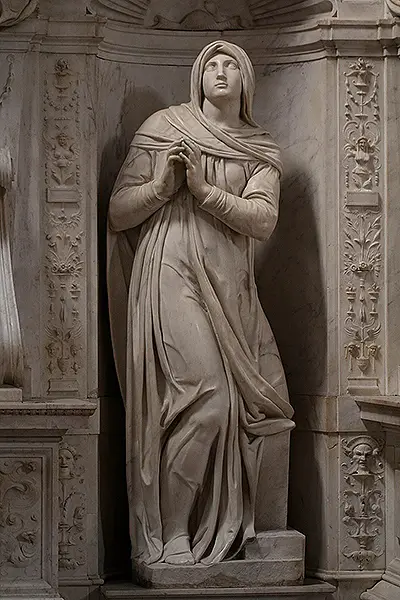The sculptor delivered the two female sculptures in the 1540s having been involved in this tomb project for around four decades. He would normally work on several commissions at the same time, which enabled him to better adapt to exciting new requests, but also meant that his work on each would take much longer. He had a number of assistants who would help out with this considerable workload, and slowly gained more trust in them as he started to give them more challenging tasks. In Renaissance Italy, of course, there was a large number of highly skilled craftsmen who would be entirely honoured to be involved alongside this great master, and he would dish out tasks depending on the level of experience and technical strengths of each worker. We have found records of contracts and payments from his lifetime which further expand our knowledge of these relationships, with Michelangelo being amongst the more researched artists of all time. Without his ability to accept help, Michelangelo may never have been able to take on his greatest commissions, such as Pieta, David or the Sistine Chapel ceiling.
There are many different interpretations of the two figures, but most believe it to be a signal of two alternative ways of living a fruitful life, with Rachel representing faith, whilst Leah follows a work-based path. They therefore offers different routes to success, but are not directly opposed to each other as such. This contrasts with many artworks from the Renaissance era, where dramatic items would be placed against each other in a very clear and obvious manner, such as with the use of Heaven and Hell, for example. Michelangelo was instead complementing Moses with these two pieces which were placed either side and complemented each other and the overall tomb as a whole. That said, others have disputed this by bringing in other forms of literature as potential inspirations on the sculptor for this set of sculptures. So much has been said about the artist over the years, but most content available to us on Leah and Rachel remains in Italian texts because they are not as well known as his more famous creations.
Rachel was directed by Michelangelo in its latter stages, where cleaning and polishing duties were taken on by other sculptors with whom he was familiar. This enabled the sculptor to plan other upcoming projects and also to constantly oversee the overall direction of the tomb, rather than being lost in the smaller details of both pieces. Finance was freely available during this period from a variety of sources and so it was entirely possible for him to call on additional sources of help, and contract agreements have been uncovered by researchers which unveil some of these arrangements. Contract law was certainly a developing element of European life during the Renaissance, but Italy was certainly ahead of most at that stage, meaning contracts were signed and also preserved as evidence, were any issues to later arise. Whilst we take for granted such a scenario now, many parts of modern society were still being progressed over time across Europe during the 15th and 16th centuries, right up until the mid to late 20th century.


